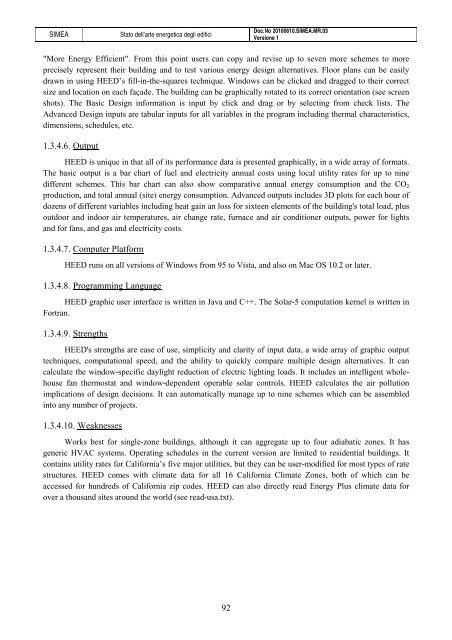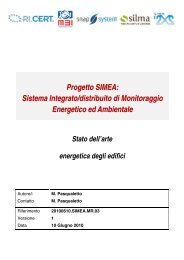Progetto SIMEA - Automatica - Università degli Studi di Padova
Progetto SIMEA - Automatica - Università degli Studi di Padova
Progetto SIMEA - Automatica - Università degli Studi di Padova
Create successful ePaper yourself
Turn your PDF publications into a flip-book with our unique Google optimized e-Paper software.
<strong>SIMEA</strong> Stato dell’arte energetica <strong>degli</strong> e<strong>di</strong>fici<br />
92<br />
Doc.No 20100610.<strong>SIMEA</strong>.MR.03<br />
Versione 1<br />
"More Energy Efficient". From this point users can copy and revise up to seven more schemes to more<br />
precisely represent their buil<strong>di</strong>ng and to test various energy design alternatives. Floor plans can be easily<br />
drawn in using HEED’s fill-in-the-squares technique. Windows can be clicked and dragged to their correct<br />
size and location on each façade. The buil<strong>di</strong>ng can be graphically rotated to its correct orientation (see screen<br />
shots). The Basic Design information is input by click and drag or by selecting from check lists. The<br />
Advanced Design inputs are tabular inputs for all variables in the program inclu<strong>di</strong>ng thermal characteristics,<br />
<strong>di</strong>mensions, schedules, etc.<br />
1.3.4.6. Output<br />
HEED is unique in that all of its performance data is presented graphically, in a wide array of formats.<br />
The basic output is a bar chart of fuel and electricity annual costs using local utility rates for up to nine<br />
<strong>di</strong>fferent schemes. This bar chart can also show comparative annual energy consumption and the CO2<br />
production, and total annual (site) energy consumption. Advanced outputs includes 3D plots for each hour of<br />
dozens of <strong>di</strong>fferent variables inclu<strong>di</strong>ng heat gain an loss for sixteen elements of the buil<strong>di</strong>ng's total load, plus<br />
outdoor and indoor air temperatures, air change rate, furnace and air con<strong>di</strong>tioner outputs, power for lights<br />
and for fans, and gas and electricity costs.<br />
1.3.4.7. Computer Platform<br />
HEED runs on all versions of Windows from 95 to Vista, and also on Mac OS 10.2 or later.<br />
1.3.4.8. Programming Language<br />
HEED graphic user interface is written in Java and C++. The Solar-5 computation kernel is written in<br />
Fortran.<br />
1.3.4.9. Strengths<br />
HEED's strengths are ease of use, simplicity and clarity of input data, a wide array of graphic output<br />
techniques, computational speed, and the ability to quickly compare multiple design alternatives. It can<br />
calculate the window-specific daylight reduction of electric lighting loads. It includes an intelligent wholehouse<br />
fan thermostat and window-dependent operable solar controls. HEED calculates the air pollution<br />
implications of design decisions. It can automatically manage up to nine schemes which can be assembled<br />
into any number of projects.<br />
1.3.4.10. Weaknesses<br />
Works best for single-zone buil<strong>di</strong>ngs, although it can aggregate up to four a<strong>di</strong>abatic zones. It has<br />
generic HVAC systems. Operating schedules in the current version are limited to residential buil<strong>di</strong>ngs. It<br />
contains utility rates for California’s five major utilities, but they can be user-mo<strong>di</strong>fied for most types of rate<br />
structures. HEED comes with climate data for all 16 California Climate Zones, both of which can be<br />
accessed for hundreds of California zip codes. HEED can also <strong>di</strong>rectly read Energy Plus climate data for<br />
over a thousand sites around the world (see read-usa.txt).
















